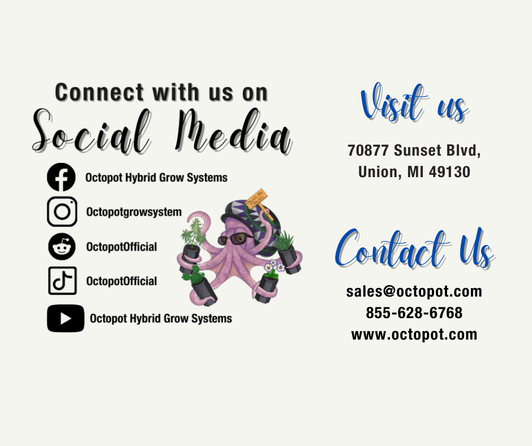|
Deep Dive into Light. Octopot Education:
Light is the most important limiting factor when growing indoors, so what kind of supplemental light should you use? With so many options out there to choose from it can be difficult to know where to start. In our chapter on artificial lighting, we look at the three main types of lights used for indoor growing; Fluorescent, High Intensity Discharge (HID), and Light Emitting Diodes (LED). In Part one we look specifically look at Fluorescent and HID lighting.
0 Comments
Integrated Pest Management. Octopot Education:
In our third post on IPM we look at common physical controls, using biological controls (bios), and lastly chemical controls as management strategies of pest pressure in our grow. Is all this a bit over whelming or above your pay grade? We also consider what to look for in an IPM consultant. Integrated Pest Management. Octopot Education:
In our second post on IPM we continue discussing monitoring strategies with key pests we should be looking for in our cannabis garden. We also touch on some tools to assist monitoring and discuss the microbial side of pests. Feel free to pause the slide show to get close up and personal in identifying these buggers! Deep Dive into Light. Octopot Education:
We know plants love growing under the sun as nature intended, but not all growers have this option. Greenhouses are a good solution but not perfect when it comes to adequate lighting. Consider artificial lights! All About Water. Octopot Education:
In this post on water, we identify problems with conventional crop production and its effects on the environment. We also highlight scary stats on water usage, define the term Evapotranspiration, and explain why Octopots are so good at conserving water and better for the environment. Integrated Pest Management. Octopot Education:
What is Integrated Pest Management (IPM) and why do you need it? In this post we talk about proactive control strategies to help keep your grow healthy and profitable. There is a quote that roughly states, "the best fertilizer is the shadow of the farmer." Although not literal in its application, it does speak to the importance of always being present in your grow, observing. Here we take a "best practices" approach to scouting and the tools/methods to effectively identify issues before they become problems in your grow. Then we scratch the surface of monitoring and consider what should we be looking for before things get out of hand. Deep Dive into Light. Octopot Education:
What are the light cycle needs of our cannabis plants? Many growers understand how important the period of light (photoperiod) is relative to producing great flowers, but it's the amount of darkness (scotoperiod) that is most influential in optimizing plant flowering; except for day-neutral plants! Huh? Let's take a look. Deep Dive Into Light. Octopot Education:
We know plants absorb light via chlorophyll, but what other plant responses are influenced by light and specifically what kind of light? In this post we acknowledge light wavelength shifts, and evolutionary responses from plants. We also look at how plants use light even before they emerge from the soil! Plants don't use clocks or watches, so how do they know when it's day, night, or when to flower? We identify Photoperiodism and dive into the science of phytochrome and its relation to Red & Far-red spectrums of light. All About Water. Octopot Education:
In our previous posts on water, we identified how Octopots grow both hydroponically and via the soil. What exactly are the differences between roots growing in just water and roots growing in soil? What is Hydro-patterning, what affects root growth in soil, and what on earth is Root Hybridization? There may be more to it than you think. Your Grow Media. Octopot Education:
In Part four of our grow media posts we look at three common mediums for growing your plants. We identify how some grow media work better than others in your Octopot and highlight one key consideration for an optimal root system and high yielding grow. |

 RSS Feed
RSS Feed
